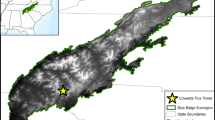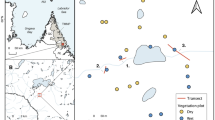Abstract
Vegetation actively affects different components of the water budget in multiple spatial and temporal scales. Changes in vegetation cover and structure—such as those resulting from land use—alter natural ecohydrological dynamics, leading to changes in natural hydrologic regimes. In tropical mountain ecosystems, such as the Colombian Andes, significant areas of native forests have been converted to agro-ecosystems that include pasturelands and croplands, to supply societal demands for other ecosystem services. Yet, services such as water provision and hydropower generation that depend on the regulation of hydrologic fluxes are also demanded from these ecosystems, potentially generating conflicting societal demands. In this study, we assess the effect of vegetation cover type and rainfall seasonality on the dynamics of hydrological partitioning—an indicator of hydrologic regulation—at three temporal scales, in a simulated gradient of human disturbance characterized by seven types of vegetation cover. Overall, vegetation cover effects on hydrologic partitioning are more pronounced in shorter, weekly to seasonal, timescales than in annual timescales. Natural vegetation cover types have a higher potential for maintaining water availability, as evidenced by lower variability of soil moisture storage and hydrological fluxes both within and between seasons. Notably, among all cover types, early stages of natural vegetation recovery appear to be more effective in maintaining higher levels of soil moisture while decreasing potential overland flow and other water losses, therefore more effectively contributing to deep drainage and potentially to groundwater recharge, which relate to hydrologic regulation and, ultimately, water availability. Collectively, our results provide insights for decision-making in land management, particualrly when provisioning and regulatory ecosystem services are demanded from these strategic ecosystems.








Similar content being viewed by others
References
Allen CD, Breshears DD, McDowell NG (2015) On underestimation of global vulnerability to tree mortality and forest die-off from hotter drought in the Anthropocene. Ecosphere 6(8):1–55. https://doi.org/10.1890/ES15-00203.1
Bosch JM, Hewlett JD (1982) A review of catchment experiments to determine the effect of vegetation changes on water yield and evapotranspiration. J Hydrol 55:3–23. https://doi.org/10.1016/0022-1694(82)90117-2
Brown A, Zhang L, McMahon T, Weston A, Vertessy R (2005) A review of paired catchment studies for determining changes in water yield resulting from alterations in vegetation. J Hydrol 310:28–61. https://doi.org/10.1016/j.jhydrol.2004.12.010
Bruijnzeel LA (2004) Hydrological functions of tropical forest: not seeing the soil for the trees? Agric Ecosyst Environ 104:185–228. https://doi.org/10.1016/j.agee.2004.01.015
Carpenter SR, Bennett EM, Peterson GD (2006) Scenarios for ecosystems services: an overview. Ecol Soc 11(1):29. https://doi.org/10.5751/ES-01610-110129
Chandler DG, Walter MF (1998) Runoff responses among common land use in the upland of Matalom, Leyte, Philippines. Trans ASAE 41:1635–1641. 10.13031/2013.17338
Crk T, Uriarte M, Corsi F, Flynn D (2009) Forest recovery in a tropical landscape: what is the relative importance of biophysical, socioeconomic, and landscape variables? Landsc Ecol 24:629–642. https://doi.org/10.1007/s10980-009-9338-8
DeFries RS, Rudel T, Uriarte M, Hansen M (2010) Deforestation driven by urban population growth and agricultural trade in the twenty-first century. Nat Geosci 3:178–181. https://doi.org/10.1038/ngeo756
Empresas Públicas de Medellín (2005) Cincuenta años de hidrometeorología en Empresas Públicas de Medellín. Rev Hidrometeorol 1:1 ISSN 1900–7248
Fleischbein K, Wilcke W, Valarezo C, Zech W, Knoblich K (2006) Water budgets of three small catchments under montane forest in Ecuador: experimental and modelling approach. Hydrol Process 20:2491–2507. https://doi.org/10.1002/hyp.621.
Foley JA, De Fries R (2005) Global consequences of land use. Science 309(5734):570–574. https://doi.org/10.1126/science.1111772
Giambelluca TW, Nullet M, Ziegler AD, Tran L (2000) Latent and sensible energy flux over deforested land surfaces in the eastern Amazon and northern Thailand. Singap J Trop Geogr 21:107–130. https://doi.org/10.1111/1467-9493.00070
Gibbs HK, Ruesch AS, Achard F, Clayton MK, Holmgren P, Ramankutty N, Foley JA (2010) Tropical forests were the primary sources of new agricultural land in the 1980s and 1990s. Proc Natl Acad Sci U S A 107:16732–16737. https://doi.org/10.1073/pnas.0910275107.
Hassan RM, Scholes R, Ash N et al (2005) Ecosystems and human well-being: current state and trends, vol 1. Millenium Ecosystem Assessment Board. Island Press, Washington DC
Hassler S, Zimmermann B, Van Breugel M, Hall JSH (2011) Recovery of saturated hydraulic conductivity under secondary succession on former pasture in the humid tropics. For Ecol Manag 261:1634–1642. https://doi.org/10.1016/j.foreco.2010.06.031
Holdridge LR (1967) Life zone ecology. Tropical Science Center, San Jose Kittel, T.G.F., Rosenb
Hollander M, Wolfe DA (1999) Nonparametric statistical methods, 2nd edn. John Wiley & Sons, Inc, New York
Holwerda F, Scatena FN, Bruijnzeel LA (2006) Throughfall in a Puerto Rican lower montane rain forest: a comparison of sampling strategies. J Hydrol 324:592–602. https://doi.org/10.1016/j.jhydrol.2005.12.014
Hothorn T, Hornik K, van de Wiel MA, Zeileis A (2006) A lego system for conditional inference. Am Stat 60(3):257–263. https://doi.org/10.1198/000313006X118430
Hothorn T, Bretz F, Westfall P (2008) Simultaneous inference in general parametric models. Biom J 50(3):346–363. https://doi.org/10.1002/bimj.200810425
Huxman TE, Smith MD, Fay PA, Knapp AK, Shaw MR et al (2004) Convergence across biomes to a common rain-use efficiency. Nature 429:651–654. https://doi.org/10.1038/nature02597.
IGAC (2007) Estudio general de suelos y zonificación de tierras departamento de Antioquia. Imprenta Nacional de Colombia, Bogotá
Jobbágy EG, Nosetto M, Santoni C, Baldi G (2008) El desafío ecohidrológico de las transiciones entre sistemas leñosos y herbáceos en la llanura Chaco Pampeana. In: Roset P (Ed) Ecología Austral, Vol 18, 3rd edn. Asociación Argentina de Ecología, San Luís, pp 305–322
Juhrbandt J, Leuschner C, Hölscher D (2004) The relationship between maximal stomatal conductance and leaf traits in eight Southeast Asian early successional tree species. For Ecol Manag 202(1–3):245–256. https://doi.org/10.1016/j.foreco.2004.07.021
Krishnaswamy J, Bonell M, Venkatesh B, Purandara BK, Lele S, Kiran MC, Reddy V, Badiger S, Rakesh VN (2012) The rain-runoff response of tropical humid forest ecosystems to use and reforestation in the Western Ghats of India. J Hydrol 472–473:216–237. https://doi.org/10.1016/j.jhydrol.2012.09.016
Lo MH, Famiglietti J, Yeh P, Syed T (2010) Improving parameter estimation and water table depth simulation in a land surface model using GRACE water storage and estimated base flow data. Water Resour Res 46:W05517. https://doi.org/10.1029/2009WR007855
Mishra N, Khare D, Gupta KK, Shukla R (2014) Impact of land use change on groundwater—a review. Adv Water Resour Protect (AWRP) 2:28–41
Molina A, Govers G, Vanacker V, Poesen J, Zeelmaekers E, Cisneros F (2007) Runoff generation in a degraded Andean ecosystem: interaction of vegetation cover and land use. Catena 71(2):357–370. https://doi.org/10.1016/j.catena.2007.04.002
Monteith JL (1965) Evaporation and environment. Symposium of the Society for Experimental Biology, The State and Movement of Water in Living Organisms. 19: 205–234, Academic Press, Inc., NY.
Mukul SA, Herbohn J (2016) The impacts of shifting cultivation on secondary forest dynamics in tropics: a synthesis of the key findings and spatio temporal distribution of research. Environ Sci Policy 55:167–177. https://doi.org/10.1016/j.envsci.2015.10.005
Mukul SA, Herbohn J, Firn J (2016) Tropical secondary forests regeneration after shifting cultivation in the Philippines uplands are important carbon sinks. Sci Rep 6:22483. https://doi.org/10.1038/srep22483.
Muñoz-Villers LE, McDonnell JJ (2013) Land use change effects on runoff generation in a humid tropical montane cloud forest region. Hydrol Earth Syst Sci 17:3543–3560. https://doi.org/10.5194/hess-17-3543-2013
Muñoz-Villers LE, Geissert DR, McDonnell JJ (2016) Factors influencing stream baseflow transit times in tropical montane watersheds. Hydrol Earth Syst Sci 20(4):1621–1635. https://doi.org/10.5194/hess-20-1621-2016
Nosetto MD, Jobbágy EG, Brizuela AB, Jackson RB (2012) The hydrologic consequences of land cover change in central Argentina. Agric Ecosyst Environ 154:2–11. https://doi.org/10.1016/j.agee.2011.01.008
Nunes AN, de Almeida AC, Coelho COA (2011) Impacts of land use and cover type on runoff and soil erosion in a marginal area of Portugal. Appl Geogr 31:687–699. https://doi.org/10.1016/j.apgeog.2010.12.006
Poveda G (2004) La hidroclimatología de Colombia: una síntesis desde la escala inter-decadal hasta la escala diurnal. Rev Acad Colombiana Cienc 28(107):201–222 ISSN: 0370-3908
Radulovich R, Sollins P (1987) Improved performance of zero tension lysimeters. Soil Sci Soc Amer J 51:1386–1388
Ramírez BH, van der Ploeg M, Teuling AJ, Ganzeveld L, Leemans R (2017) Tropical montane cloud forests in the Orinoco river basin: the role of soil organic layers in water storage and release. Geoderma 298:14–26. https://doi.org/10.1016/j.geoderma.2017.03.007
Recha JW, Johannes L (2012) Stream discharge in tropical headwater catchments as a result of forest clearing and soil degradation. Earth Interact 16(13):1. https://doi.org/10.1175/2012EI000439.1
Rodriguez-Iturbe I (2000) Ecohydrology: a hydrologic perspective of climate-soil-vegetations dynamics. Water Resour Res 36(1):3–9. https://doi.org/10.1029/1999WR900210
Salazar JF, Villegas JC, Rendón AM, Rodríguez E, Hoyos I, Mercado-Bettín D, Poveda G (2017) Scaling properties reveal regulation of river flows in the Amazon through a “forest reservoir”. Hydrol Earth Syst Sci Discuss. https://doi.org/10.5194/hess-2017-278
Suescún D, Villegas JC, León JD, Flórez CP, García-Leoz V, Correa GA (2017) Vegetation cover and rainfall seasonality impact nutrient loss via runoff and erosion in the Colombian Andes. Reg Environ Chang 17(3):827–839. https://doi.org/10.1007/s10113-016-1071-7
Tejedor N, Álvarez E, Arango S, Araujo A, Blundo C, Boza TE (2012) Evaluación del estado de conservación de los bosques montanos en los Andes tropicales. Ecosistemas 21(1–2):148–166
Thornthwaite CW, Mather JR (1957) Instructions and tables for computing potential evapotranspiration and the water balance. Lab Climatol 10(3):127
Van der Hammen T (1983) Aspectos de historia y ecología de la biodiversidad norandina y amazónica. Rev Acad Colombiana Cienc 24(9):231–245 ISSN 0370-3908
Vedovato L, Gesteira M, Areai L, Oighenstein L, Anderson L, Aragão CO (2016) The extent of 2014 forest fragmentation in the Brazilian Amazon. Reg Environ Chang. https://doi.org/10.1007/s10113-016-1067-3
Veneklass EJ, Van Ek R (1990) Rainfall interception in two tropical mountain rain forest, Colombia. Hydrol Process 4:311–326. https://doi.org/10.1002/hyp.3360040403
Vis M (1986) Interception, drop size distributions and rainfall kinetic in four Colombian forest ecosystems. Earth Surf Process Landf 11:591–570. https://doi.org/10.1002/esp.3290110603
Wang S, Fu B, Gao G, Liu Y, Zhou J (2013) Responses of soil moisture in different land cover types to rainfall events in a re-vegetation catchment area of the Loess Plateau, China. Catena 101:122–128. https://doi.org/10.1016/j.catena.2012.10.006
Zimmermann B, Zimmermann A, Scheckenbach HL, Schmid T, Hall JS, Van Breugel M (2013) Change in rainfall interception along a secondary forest succession gradient in lowland Panama. Hydrol Earth Syst Sci 17:4659–4670. https://doi.org/10.5194/hess-17-4659-2013.
Acknowledgments
We thank Óscar and Martha Pérez for access and logistics at the field site and who made possible the infiltration tests.
Funding
Funding was provided by “Programa de investigación en la gestión de riesgo asociado con cambio climático y ambiental en cuencas hidrográficas”, Convocatoria 543-2011 Colciencias; partial funding from IAEA Research Contract 17351. Luis Merino-Martín was funded by Marie Curie IEF fellowships (ref. 626666/2013). Field and laboratory support by A.I. Cardona, A.M. Martín, J. Sánchez, L.I. Arango, Y.A. Vélez, C.J. Caraballo, E.J. Guana, J.S. Orozco, C. Duque and D. García.
Author information
Authors and Affiliations
Corresponding authors
Additional information
Editor: Juan Ignacio Lopez Moreno.
Rights and permissions
About this article
Cite this article
García-Leoz, V., Villegas, J.C., Suescún, D. et al. Land cover effects on water balance partitioning in the Colombian Andes: improved water availability in early stages of natural vegetation recovery. Reg Environ Change 18, 1117–1129 (2018). https://doi.org/10.1007/s10113-017-1249-7
Received:
Accepted:
Published:
Issue Date:
DOI: https://doi.org/10.1007/s10113-017-1249-7




